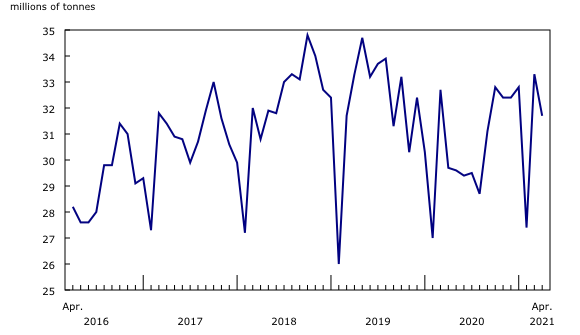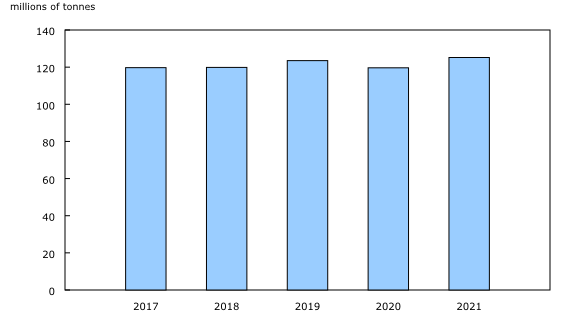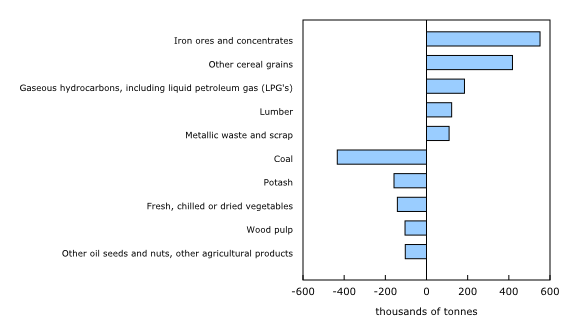Railway carloadings, April 2021
Archived Content
Information identified as archived is provided for reference, research or recordkeeping purposes. It is not subject to the Government of Canada Web Standards and has not been altered or updated since it was archived. Please "contact us" to request a format other than those available.
Released: 2021-06-29
31.7 million metric tonnes
April 2021
6.7% 
(12-month change)
Highlights
Canadian railways carried 31.7 million tonnes of freight in April. This was up 6.7% from 29.7 million tonnes in April 2020 when rail traffic volumes fell to a 5-year low due to widespread shutdowns at the onset of the COVID-19 pandemic.
April was the sixth consecutive month of a year-over-year increase, with the overall volume well above the five-year average for this month and second only to the record volume of 33.3 million tonnes reached in April 2019.
To further explore current and historical data in an interactive format, please visit the Monthly Railway Carloadings: Interactive Dashboard.
Cumulative tonnage on track with 2019
On a year-to-date basis through April, total cargo volume moved by rail amounted to 125.2 million tonnes, rising 4.6% compared with the same period a year earlier. This was the highest cumulative total ever recorded for the January-to-April period.
The traffic growth in April was the result of higher volumes across all types of rail operations.
Iron ores and concentrates up
Non-intermodal rail operations in Canada increased 3.3% year over year to 25.1 million tonnes, with broad-based increases for many commodities. The largest increase was reported in iron ores and concentrates, with loadings rising 13.8% (+552 000 tonnes) in April compared with the same month in 2020, marking the sixth consecutive month of year-over-year growth.
With stimulus packages focused on infrastructure and construction, it appears that additional steel production has increased demand for iron ores. Indeed, according to the Monthly Survey of Manufacturing, the primary metal industry reported a seventh consecutive monthly increase in seasonally adjusted sales during April.
Loadings of other cereal grains posted a year-over-year increase for a 13th straight month, surging 88.1% (+418 000 tonnes) from April 2020. This was the second-highest monthly increase in tonnage since last April, reflecting the continued strong demand for Canadian-grown grains.
In addition, loadings of gaseous hydrocarbons, including liquid petroleum gas (LPG's) grew 42.4% (+184 000 tonnes) from April 2020, following strong gains in March (+31.5%) and February (+39.2%).
Loadings of lumber have increased year over year for eight straight months, up 15.3% (+122 000 tonnes) in April, reflecting strong demand from the renovation sector and housing market.
Other significant increases were also reported for metallic waste and scrap, with loadings up 58.3% (+110 000 tonnes) in April from the same period a year ago.
Coal dampens volumes
Moderating these increases were large declines in several commodities. Loadings of coal fell 14.0% (-433 000 tonnes) from April 2020, the third consecutive year-over-year decline. While less than the previous month's drop (-18.3%), this may reflect weakness in demand for industrial energy in many countries amid a resurgence of COVID-19.
Similarly, potash loadings dipped 7.0% (-158 000 tonnes) year-over-year in April, a third consecutive month of decline.
Other significant decreases were reported in loadings of many agricultural and food products. Loadings of fresh, chilled or dried vegetables decreased 24.1% (-141 000 tonnes) year over year in April, while loadings for other oil seeds and nuts, and other agricultural products were down 65.2% (-103 000 tonnes) – their first decline in nine months.
Finally, loadings of wood pulp were 15.8% lower (-104 000 tonnes) in April compared with April 2020, the third consecutive monthly decline.
Intermodal loadings continue to surge
Intermodal loadings—mainly containers—also contributed to the overall growth in April, increasing by 27.8% from April 2020 to 3.2 million tonnes, the second-highest volume for this month on record. This rise followed an even stronger year-over-year growth in March (+37.4%) and February (+42.4%).
Higher imports of consumer goods for inventory replenishment and to meet demands from online shopping continued to foster this intermodal growth. As reported earlier in Canadian international merchandise trade, Canada's imports of consumer goods posted a year-over-year increase of 18.7% in April.
American freight is up
After substantial year-over-year declines for over a year, loadings from American railways rose 17.2% to 3.4 million tonnes in April compared with the same month last year, the highest April traffic level since 2018.
Note to readers
Data are subject to revisions. The monthly railway carloadings data are revised, on a monthly basis, for the month immediately prior to the current reference month being published to reflect new information provided by respondents. The data in this release are not seasonally adjusted.
The Monthly Railway Carloadings Survey collects data on the number of rail cars, tonnage, units and 20-feet equivalent units from railway transporters operating in Canada that provide for-hire freight services.
The Transportation Data and Information Hub, a web portal developed jointly by Statistics Canada and Transport Canada, provides Canadians with online access to comprehensive statistics and measures on the country's transportation sector.
Contact information
For more information, or to enquire about the concepts, methods or data quality of this release, contact us (toll-free 1-800-263-1136; 514-283-8300; STATCAN.infostats-infostats.STATCAN@canada.ca) or Media Relations (613-951-4636; STATCAN.mediahotline-ligneinfomedias.STATCAN@canada.ca).
- Date modified:




